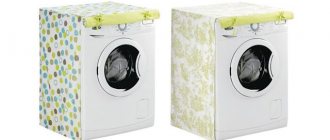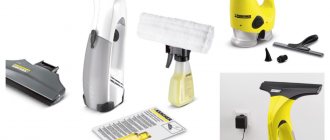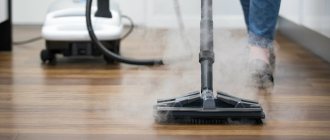In this article, we will take a closer look at how to wash a car with a pressure washer. Pressure washing makes car washing easier, faster and more efficient. It will easily remove dirt inside the arches, on the lower part of the sills and the bottom, which is difficult to do manually. You will spend less water washing your car. The pressure washer is connected to a water source through a regular hose. A powerful motor operates a pump that pumps water and sprays it through a special nozzle with high pressure. Reduces water consumption by up to 80% compared to washing with a hose.
Safety precautions
- Using a high pressure washer requires compliance with safety precautions. Don't forget that this is not just a garden hose with a nozzle. Water comes out of the washer nozzle with 30 to 80 times more pressure than from a hose. It must be remembered that high pressure washing is quite dangerous if used incorrectly. You need to be especially careful when using nozzles that produce a narrow or pinpoint stream of water. Start working 60 cm from the surface, move no closer than 15–30 cm.
- Spraying with a wide spray is safe for both humans and the car’s paintwork. This will take longer to remove individual stubborn stains than a spot spray or narrow spray, but will reduce the risk of damage.
- If there is a power line nearby, you must maintain a distance of at least 2 meters from it.
- Do not use the washer if you are standing on a hill. Pulling the trigger may cause kickback and fall.
- Do not point the pressurized water nozzle at people or animals. Strong water flow can cause serious damage to the skin.
Comparative table of the presented funds
In order to better present and visually compare car shampoos from different manufacturers, we have compiled a comparison table that shows the main characteristics of the samples.
| Car shampoo | Manufacturer country | Canister volume | Consumption per wash (ml) | Price, rub.) |
| Hi Gear HG 8009 | USA | from 1.0 to 4.0 l | 40-80 | from 199 to 820 |
| ACTIVE PINK GRASS | Russia | from 1.0 to 24.0 l | 40-80 | from 262 to 3,750 |
| Karcher Ultra Foam Cleaner | Germany | from 1.0 to 5.0 l | 40-80 | from 519 to 1,399 |
| TURTLE WAX Essential Zip Wax | USA | from 0.5 to 1.0 l. | 40-80 | from 225 to 415 |
| Grass Foam Truck | Russia | from 1.0 to 24.0 l | 80-100 | from 280 to 3,400 |
How to prepare a high pressure washer for use
- When using an extension cord, always unwind it. The extension cord must have a cable thick enough to withstand the load imposed by the pressure washer.
- Do not use hot water with a pressure washer. Hot water can damage the rubber seals and the washer pump. The water can be warm, but should not exceed 60 degrees.
- When using a high pressure washer, there may be a lack of water, which will lead to pump failure. This is especially true with more powerful sinks that require a larger amount of continuous water flow. If the water source provides only the minimum required amount of water, then so-called cavitation (the formation of a mixture of air and water bubbles) inside the pump may occur, which may not be immediately noticed or noticed too late. Thus, the pump may fail. To make sure that the water source provides the required volume, you need to fill a bucket with a scale divided into liters per minute. This way you can calculate how much water will flow to the sink.
- Connect the hose from the water source to the sink.
- Make sure all connections are secure.
- Run water through the connected hose. The water pressure should not exceed 5 bar. Make sure the water reaches the sink. Without water, a working sink can quickly fail.
- Before turning on the washer, pull the spray gun trigger for a few seconds to bleed air from the system and relieve any remaining pressure. It is very important to run water through the sink so that it flows through the gun when the trigger is pulled. This must be done before turning on the sink, within one minute. This way, any air is released from the system before using the washer.
- Continue pressing the trigger and turn on the washer.
Choices.
If you need an inexpensive but reliable mini washer for washing walls, paths and fences, choose among low-power models with durable metal pumps. These will cost in the range of 4000 - 7300 rubles.
If you need a mini-wash to wash one car “from time to time,” you can choose an inexpensive model from washers with a maximum pressure of 120 bar. Prices for such models start from 5,000 rubles.
For comfortable car washing, both from the water supply and from a container, it is better to choose a model with a higher maximum pressure - from 135 bar - and corresponding performance. Such sinks will cost from 7,300 rubles.
If you plan to use the car wash more often than 1-2 times a week - not only for washing the car, but also for other work of varying duration, you should choose models with a pressure of 120 bar and metal pumps at a price of 5,000 to 14,300 rubles.
And finally, to wash large equipment and large surfaces, you will need high-performance washers with high maximum pressure. It will cost you 27,000-31,000 rubles.
How to wash with a high pressure washer?
- Before washing your car, make sure all windows are tightly closed.
- Washing with water under pressure is carried out in the same order as when using a hose and washing sponges and mittens, from top to bottom (when applying foam from bottom to top).
- The initial trigger pull of the spray gun may produce a stream of water with excessive pressure exceeding the operating pressure. For this reason, when you first pull the trigger, you should point the spray nozzle away from the vehicle. A sharp flow with high pressure can damage the paintwork or plastic of the headlight.
- It is recommended to apply the foam to a dry surface. A wet surface will dilute the foam and reduce its effectiveness. Therefore, if the car is not very dirty, then the foam can be applied immediately. However, if there is a thick layer of dirt, it is better to first rinse the machine using a wide or medium torch and high water pressure to wash away dirt, salt and sand.
- You need to start at a distance of at least 50 cm from the surface and move no closer than 15–30 cm, at an angle of 25–45 degrees, so that dirt does not affect the paintwork.
- After the car is free of major dirt, apply detergent. To apply foam, a special foam nozzle is used. We will look at the effect of foam and the subtleties of its application in more detail below. Use only a product that is approved for use with a pressure washer. On vertical surfaces, apply foam from bottom to top. This way it will hold on better and not slide off ahead of time.
- Wait a few minutes for the product to take effect. Next, after 3-5 minutes, wash off the foam with water with a wide jet and high pressure. Maintain a distance of at least 30 cm from the surface. The product will weaken the most difficult to remove stains and oil stains.
- You should always hold the nozzle at an angle to the surface, ideally at an angle pointing downwards. This way, dirt and foam will not be splashed onto the newly washed surface. Spraying at an angle to the surface (25–45 degrees), as already mentioned, avoids scratches from washed-off solid contaminants.
- Depending on the degree of contamination of the car, applying and rinsing off foam may be sufficient, or further hand washing with a special microfiber mitt or sponge with or without car shampoo may be required.
To wash the car, a special brush can be used, which is attached to the spray gun. If you use the same brush for the wheels and for the body, then wash the wheels last so that abrasive from the pads or a small stone does not get on the body.- A lot of dirt and salt stick to the bottom, so don't forget to wash it. Use a special lance for this purpose, spraying at an angle. When using the underbody cleaning attachment (optional), always rest it firmly on the floor to avoid kickback and rotation.
- The final rinse can be done by removing the high pressure nozzle completely.
Exactly the opposite
Karcher car wash
So, if you want to wash your car at home, then remember everything that you saw in the car wash service. Do you remember? Now - forget it! Once and for all. With all due respect to car washes, they have one goal - to wash quickly. But ours is completely different - to wash it efficiently and correctly.
• First, never wet your car before washing it. The foam should be applied to a dry surface. Yes, yes, for a dry and dirty car. After all, on a wet surface, the chemical will instantly slide onto the floor. And we need it to “contact” the dirt, “catch” on it and begin its action.
• Secondly, top-down is a big mistake. You need to start not from the roof of the car, but from the bottom.
This is how we will create a “barrier” that will prevent the chemistry from sliding down. First of all, the doors. Then you should cover the back part - the wings, and then the roof - with cleaning foam. The hood (front) is usually left for last. If the car has been parked in the garage for a long time, then this does not matter, but if it is driven, then the engine has not yet cooled down. The hood is hot, so the foam will dry out quickly, which is not what we want.
This is interesting: How many horses are there in the car?
Details about applying foam to a car
There are sink models that have a built-in container for detergent, or a separate outlet with a hose that can suck detergent from an external container. Using these containers it is impossible to obtain thick foam. To coat your car with thick foam, you need to use a foam nozzle that connects to the end of the spray gun barrel.
The detergent container and the foam nozzle do different jobs. Different detergents are used. The detergent bottle mixes detergent and water together to help clean the surface better without producing a lot of suds. The foam created by the foam nozzle remains on the surface for some time, weakens and dissolves adhering dirt. After washing off the foam, most of the dirt that could scratch the paint during hand washing is washed away. It does not leave streaks or traces behind, as can be the case with car shampoo sprayed from the container built into the sink.
Foam nozzle
The foam nozzle is designed quite simply. It works by forcing water through a narrowing channel. This increases the speed of the water and creates a zone of low pressure at the inlet of the suction tube, through which the product enters the nozzle itself (this is called the Venturi principle). Thanks to the pressed mesh insert, the mixture of water and foaming agent is whipped and foam is formed. Most foam lances have a mixing valve that allows you to control the ratio of product to water, creating a thicker or thinner foam. Also, most foam nozzles can change the spray angle from horizontal to vertical.
Applying thick foam is a preliminary step before regular hand washing using special gloves or sponges. You can read the article “how to properly wash a car,” which describes the process of manual washing, which reduces the likelihood of scratches. In the instructions for using foam lances and the foaming agent itself, this process is called prewash. If the car body is regularly waxed, then only applying and rinsing off the foam may be sufficient. Sometimes, after washing off the foam, it is enough to wash the surface of the car without car shampoo, with clean water and a special microfiber mitt.
It doesn’t matter how thick the foam layer is. A layer that is too thick only looks impressive, but the effect is the foam that touches the surface of the car. The advantage of thick foam is that it can remain on the entire surface of the car for several minutes without slipping. This gives it the opportunity to act on contaminants and lift them from the surface.
Let us consider in detail the process of preparing the foam nozzle and applying the foam.
- Different foam lances may produce foam differently. A good, expensive foam nozzle will create a rich, thick foam. The density of the foam is also affected by the proportion of water and foaming agent.
- Typically, the ratio of the mixture of water to the product is 10 to 1. The bottle of the foam nozzle has a volume of 1 liter and is filled to a certain mark (900 ml). Next, add foaming agent (100 ml). The product can be added last so that it does not foam ahead of time, while pouring water, then, after screwing the bottle to the nozzle, it will need to be shaken. You can pour in the opposite way, first the product, and then slowly add water with a small pressure. Thus, the product will be mixed already in the process of pouring water.
- Next, screw the bottle to the nozzle itself, and the nozzle to the spray gun. The top regulator adjusts the amount of foam, and the width of the spray pattern can be adjusted on the nozzle.
Foam nozzles of different quality can apply the same product in different ways. In the photo on the left, the foam was applied with a cheap foam nozzle, and on the right, a more expensive one.
- Before applying foam, you need to make sure that the body is not hot. If you wash your car outside, the weather should not be windy or hot. It is better to wash your car early in the morning or late in the evening. This will reduce the evaporation (drying) time of the foam.
- It is recommended that the washer pressure regulator be set to low pressure.
- When applying foam, the nozzle should be located about 1 meter from the surface.
- On vertical surfaces, apply horizontally from side to side, starting from the bottom of the car.
- When applying foam to a car, try to do it methodically, panel by panel, as if you were painting a wall. There is no need to apply foam to the same area several times. Apply the foam slowly, from left to right and from right to left, in long passes.
- It is important that the foam remains on the surface for 3-5 minutes and does not completely drain ahead of time. This will give the active substances time to act on the contaminants.
- After exposure to the product, rinse it off with clean water under pressure. On vertical surfaces, rinse from bottom to top and then from top to bottom. Hold the nozzle 15–30 cm from the surface, at an angle of 45 degrees.
- After using the foam nozzle, it is important to thoroughly rinse the spray head and bottle with suction tube. To clean, fill the bottle with clean water and spray. This way the attachment will be ready for the next use.
Mistakes in using a mini-washer
The high-pressure cleaner is easy to use, however, owners make many mistakes when trying to wash their vehicle.
Some of them are worth talking about separately:
- If you have little experience using a mini-wash, then do not take the initiative to clean someone else’s car. This is fraught with unpleasant consequences.
- We wash the car using moderate pressure. Otherwise, the putty may fall off the body.
- When buying cleaning products, you should not give preference to those that form strong foam. There were cases when she ate the top paint layer.
- Do not make sudden movements when using the washing machine.
- Surface cleaning agents should be applied evenly.
- Carefully direct the stream at doorways and other body gaps so that the liquid does not leak into the car interior.
- Try to avoid the radiator grille.
The direction of water flow does not really matter: whether it will be from bottom to top or vice versa. In the latter case, the rinsing process occurs faster.
The main mistakes that beginners make when mastering a mini-wash were presented here. To get a complete overview, it is recommended to watch the video, which clearly shows how to properly wash a car with Karcher.
So, let's summarize. If a car owner decides to save the family budget by regularly visiting private car washes and buys a high-pressure washer for personal use, then the first thing you should do is thoroughly read the operating instructions for the device. Otherwise, washing at home will ruin the appearance of the car. Read, listen and put into practice only proven advice. They will help keep the surface of the vehicle in its original appearance.
>Wash your car correctly with a Karcher - technology and useful tips
Can high pressure washing damage your car's paint?
- The main danger when using pressure washers is the distance, angle at which the water is sprayed and how it is focused.
- Older cars with peeling paint may be at risk if the nozzle is held very close to the surface.
- The most dangerous washing pressure for car paint is around 170 bar and above. A pressure washer with 90 to 150 bar will not damage the paint. That is, most inexpensive and mid-range pressure washers have a pressure that is safe for car paint. You can read more about choosing a high-pressure washer in the article “how to choose a high-pressure washer for a car.”
- Paint may be damaged if the narrow spray nozzle is aimed too close. Regardless of the pressure created by the sink, you need to start spraying water at a distance of at least 50 cm from the surface, after which the nozzle can be brought closer and moved at a distance of at least 15–30 cm from the surface.
- If your vehicle has signs of corrosion, the paint may peel off in these areas during high-pressure washing.
- The paint surface may be damaged if the body is repainted and the surface was not prepared correctly before painting. Painted plastic may also have poor adhesion to paint. The paint may peel off at the chip site.
- You need to spray water at an angle (25–45 degrees). This way the impact on the paint will be minimal.
- Never use a tornado attachment when washing your car as it can be too aggressive and may damage the paint.
Wash completion and storage
- After completing the job, turn off the water supply and press and hold the trigger until water stops coming out of the nozzle. After this, immediately turn off the washer. This will release any remaining pressure in the system.
- If possible, keep the washer warm during the cold season to avoid damage to the pump, hoses and lance.
- If the sink will be stored in an unheated garage, then you need to use a special antifreeze for the pump (Pump Guard).











